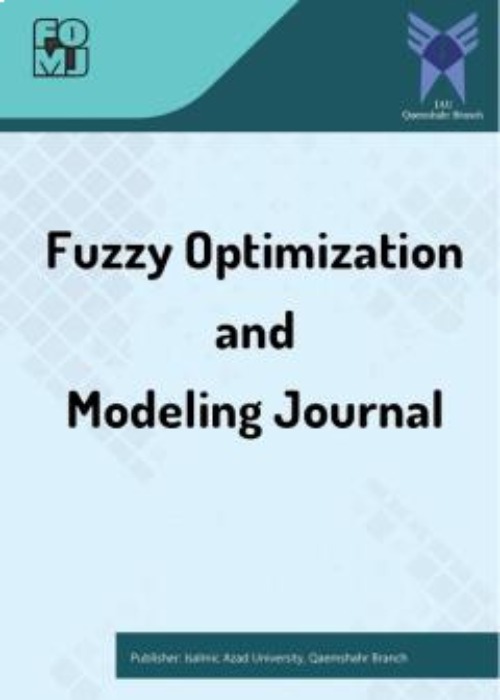فهرست مطالب

Fuzzy Optimzation and Modeling
Volume:4 Issue: 4, Autumn 2023
- تاریخ انتشار: 1402/11/21
- تعداد عناوین: 4
-
-
Pages 1-16
As the calculated efficiencies for the DMUs is relative, so each DMU attempts to improve its performance to don’t miss the position of efficiency in compete with other DMUs. Generally, the performance of DMUs can be evaluated from two perspectives-optimistic and pessimistic. A part of data envelopment analysis examines the sensitivity of the set of efficient DMUs to changes in input and output values. In real world, DEA is sometimes faced with fuzzy and interval inputs and/or outputs. In this paper we focus on the one of important subjects of sensitivity analysis and present an algorithm which uses the classic fuzzy DEA models that can determine the relative efficiency security margin of DMUs with fuzzy and interval inputs and outputs and their simultaneous perturbation. Of course, in addition to the optimistic frontier, we also consider the pessimistic frontier for the observed DMUs and call it the inefficiency improvement margin. With this information, the managers of companies can identify their closest threat and improve their performance in order to keep their position in ranking. Some numerical examples for illustration are given.
Keywords: Sensitivity analysis, Data envelopment analysis, fuzzy efficiency security margin -
Pages 17-31
English plays an increasingly important role in non-English-speaking countries, and bilingual elites with English-Chinese always make a country's economy prosperous. Thus, to efficiently promote and implement the ―English as a Medium Instruction‖ (EMI) program in higher education to raise university students’ English proficiency is inevitable. This study collects a total amount of 594 EMI important papers of articles, periodicals, books, etc., of the last 20 years from the Scopus database and sequentially conducts a bibliometric literature analysis of these papers with the VOSviewer software tool to gain the study conclusions. In network visualization analysis, especially when using tools like VOSviewer, fuzzy sets are essential for capturing the multifaceted nature of node relationships, enabling a more precise and informative representation of network structures and connections. According to the analysis results, the EMI study mainly started in 2014, and EMI papers have increased since. Four EMI majors have been focused. They are the aspects of higher education, the issues of trans-language, the perspectives of teachers and students, and the viewpoints of human social behavior. This research simultaneously arranges and provides valuable information on the journals, authors, units, institutes, and countries that have published EMI articles the most.
Keywords: VOSviewer, Bibliometric Analysis EMI, English as a Medium Instruction, Fuzzy sets -
Pages 32-47
Internet of Things describes a situation in which a large number of devices (things) are connected through a number of sensors via Internet, and lack of cooperation of some nodes in providing service to other nodes might interrupt the connection of some things, degrading network efficiency. A multi-phase mechanism based on Game theory and direct/indirect fame has been designed to motivate the selfish and malicious nodes to cooperate in IoT, which begins by deploying nodes in the IoT network. In the first phase, the nodes are grouped into clusters with cluster-heads for data collection. In the second phase, a multiplayer and dynamic game is executed while forwarding their data packet or others’ data packet. Nodes can pick their strategy when data packet forwarding in the third phase (Fuzzy logic reputation). Nodes will determine the neighboring node reputation by using fuzzy system. The amount of reputation of each of the nodes has been realized and finally, with the help of second phase and fuzzy logic, each node is decided to be cooperate or selfish nodes and in case of head clusters and fuzzy logic in some cases, the opportunity node will be reestablished to cooperate in network activities otherwise the node will be isolated. The effectiveness of the proposed solution has been assessed and the parameters of non-cooperative node detection accuracy, positive and negative warning rates, network PDR, and average endto-end latency perform better compared to other previous methods.
Keywords: fuzzy logic, Game Theory, Internet of Things (IoT), Selfish, malicious node, direct, indirect reputation -
Arithmetic Operations of Generalized Triangular Picture Fuzzy Numbers with ApplicationsPages 49-69
Picture fuzzy set is the generalization of intuitionistic fuzzy set as well as the fuzzy set considering the positive, neutral and negative membership functions of an element. In this article, we develop the arithmetic operations on generalized triangular picture fuzzy numbers by (α,γ,β)-cut method. Some related properties of them are explored. Finally, picture fuzzy linear equations are solved by using these arithmetic operations.
Keywords: Picture Fuzzy Set, Generalized Triangular Picture Fuzzy Number, Arithmetic Operations, Picture Fuzzy Linear Equations

